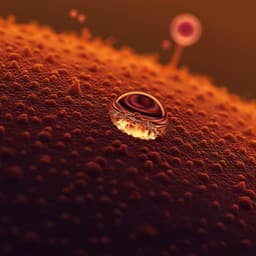
Engineering and Technology
Smart dynamic hybrid membranes with self-cleaning capability
E. Pantuso, E. Ahmed, et al.
This groundbreaking research reveals an innovative design for smart membranes that self-clean during desalination. By integrating stimuli-responsive organic crystals into the membrane's surface, a remarkable gating effect is achieved, which not only combats fouling but also enhances efficiency. This advancement promises longer operational lifetimes for desalination processes. This research was conducted by Elvira Pantuso, Ejaz Ahmed, Enrica Fontananova, Adele Brunetti, Ibrahim Tahir, Durga Prasad Karothu, Nisreen Amer Alnaji, Ghada Dushaq, Mahmoud Rasras, Panče Naumov, and Gianluca Di Profio.
~3 min • Beginner • English
Introduction
Freshwater scarcity driven by population growth, industrialization, climate change, and contamination has accelerated adoption of membrane-based desalination, particularly reverse osmosis. A major challenge is membrane fouling, which reduces flux and selectivity and necessitates chemical cleaning with environmental and durability drawbacks. Smart, stimuli-responsive membranes have been explored to provide tunable permeability, selectivity, and antifouling behavior via triggers such as temperature, light, pH, and fields. This study proposes a fundamentally different approach by embedding thermosalient (TS) organic crystals into a polymer coating on porous supports to impart dynamic, thermally activated mechanical actuation. The research question is whether integrating TS crystals that undergo rapid, reversible mechanical response slightly above room temperature can enable self-cleaning (foulant removal) and enhance mass transfer in desalination while maintaining high salt rejection, thereby extending membrane operational lifetime. Using 1,2,4,5-tetrabromobenzene (TBB) crystals embedded in a crosslinked PVA hydrogel on PVDF supports, the work evaluates flux, antifouling behavior, and stability in osmotic distillation (OD) and direct contact membrane distillation (DCMD), and investigates the gating mechanism and surface/property changes underpinning performance.
Literature Review
Prior work on smart gating membranes drew inspiration from biological ion channels and has demonstrated self-modulation of pore size/surface properties via temperature, light, pH, magnetic/electric fields, and specific ions/molecules. Hybrid gating membranes have been realized by coupling stimuli-responsive materials with porous supports or via surface functionalization. Hydrogels, in particular, enable switchable membranes with high permeation and ion rejection and have been explored for thermal cleaning and antifouling via microgels (e.g., PNIPAM-based systems). Thermosalient crystals represent a distinct class of dynamic crystalline materials that convert heat to mechanical work on millisecond scales via martensitic phase transitions, with applications in actuation, fuses, and thermal sensors. Stabilizing these crystals within soft matrices (hydrogels/polymers) enables cyclic operation. However, to date there have been no reports of membranes leveraging the TS effect for self-cleaning and flux enhancement. This work situates TS-crystal-embedded membranes within this context, comparing to thermoresponsive microgel membranes while highlighting the unique mechanical actuation-driven gating and antifouling behavior observed here.
Methodology
Materials: PVA (>99% hydrolyzed, 85,000–146,000 g mol−1), glutaraldehyde (GA, 25% aq.) as crosslinker, HCl (37%) as catalyst, PVDF porous support (0.2 μm nominal pore size), and TBB microcrystals (prepared from THF). Salts for OD/DCMD: NaCl and MgCl2·6H2O. Foulants: bovine serum albumin (BSA), sodium alginate (SA), humic acid (HA).
Membrane fabrication: Prepare 5% w/v PVA in water at ~80 °C; add GA (0.5% v/v). Disperse insoluble TBB microcrystals to achieve surface loadings 0.1–2.0 mg cm−2. Just prior to casting, add HCl catalyst and homogeneously cast the prepolymeric suspension onto washed/dried PVDF fixed on glass with a 400 μm spacer. Allow to crosslink/polymerize 24 h at room temperature. Reference PVDF-PVA (P-P) membranes were prepared identically without TBB. All membranes were thoroughly washed and stored in water/air for stability checks.
Characterization: SEM (surface/cross-sections; gold sputter-coated), DSC of TBB for TS transition, ATR-FTIR of membranes, water contact angle, zeta potential (ζ) and isoelectric point (IEP) in 0.005 M KCl across pH 2–9, uniaxial swelling displacement δ via gap change during ζ measurements. Gas permeation (CO2, H2, N2) by pressure-drop method at 25–50 °C and 2–8 bar to infer pore transport regime and mean pore size qualitatively. Variable-temperature single-crystal XRD (275–310 K) to quantify anisotropic thermal expansion of TBB below the transition. Frequency-dependent capacitance (dielectric constant) via parallel-plate capacitor (200 μm polymer layer; 0.25 cm² area) from 1 kHz–1 MHz at 25–50 °C.
OD tests: Flat-cell module (active area 3.75 cm²) in a thermostated chamber (28–48 °C). Feed: 0.5 M NaCl (with/without foulants: 100 ppm BSA, 50 ppm SA, 50 ppm HA). Drying solution: 35 wt% MgCl2. TBB-containing layer contacted the feed. Flux J calculated from mass/volume change over area and time. Salt rejection measured by conductivity and mass balance. Temperature-programmed OD sequence (28 °C → 48 °C → 28 °C) to probe TS activation.
OD fouling cycles: Five sequential 5 h cycles on the same membrane at 48 °C; between cycles membranes flushed 20 min with MilliQ water at ~22 °C. Both total and instantaneous fluxes recorded.
DCMD tests: Flat module (24 cm²). Feed: hypersaline brine 228 g L−1 TDS plus foulants (100 ppm BSA, 50 ppm SA, 50 ppm HA) at 59 °C; distillate water at 20 °C; counter-current flow at 5×10−5 m s−1 (Re ≈ 24). Three consecutive 5 h cycles with 15 min flushes at ~40 °C between runs. Flux J, overall mass transfer coefficient Bm, salt rejection, and specific thermal energy consumption (STEC) evaluated.
Key Findings
- Thermosalient activation and flux: In OD, flux J increased with temperature for all membranes. At 48 °C (above TBB transition), P-P-T0.8 and P-P-T1.0 reached 1.00 and 1.15 L h−1 m−2, respectively, versus 0.80 L h−1 m−2 for reference P-P, i.e., +24% and +43%. An optimal TBB loading of ~1.0 mg cm−2 maximized flux; higher loadings (≥1.4 mg cm−2) reduced flux, with 2.0 mg cm−2 below reference across temperatures. Arrhenius plots showed deviations near the TBB transition for loadings >0.5 mg cm−2, indicating activation of a different transport mechanism by crystal dynamics. NaCl rejection remained >99.95% (no pore wetting).
- Mechanical and surface properties: Inclusion of TBB markedly stiffened the PVA layer; swelling displacement δ decreased nearly linearly with loading and could not be measured at 2.0 mg cm−2 due to delamination. IEP increased up to 1.0 mg cm−2 then slightly decreased; at feed pH ~5.35, ζ became more negative up to 1.0 mg cm−2, consistent with pH-responsive partially hydrolyzed PVA and TBB–PVA interactions. Water contact angle decreased from ~80° (P-P) to ~60° at 1.0 mg cm−2, indicating increased hydrophilicity.
- Gas transport: H2 showed highest permeability; ideal selectivities H2/N2 = 2.8–3.9 and H2/CO2 = 2.2–3.8 (cf. Knudsen 3.7 and 4.7), indicating Knudsen-dominant transport with some viscous contribution. For P-P-T1.0, CO2 permeability at 35 °C was 12% higher than at 25 °C (reference +4%); at 50 °C, +9% versus +11.7% for reference, suggesting the TBB dynamic response partially counteracts typical negative temperature dependence in porous transport.
- Antifouling and cycling in OD: Over five OD cycles with foulants, reference P-P total flux declined by >40% (e.g., ~0.6 → ~0.3 L h−1 m−2), while P-P-T1.0 maintained ~0.9–1.1 L h−1 m−2 with only modest decline in the 5th cycle; after five cycles, average flux of TBB-loaded membranes remained >160% of undoped. Instantaneous flux rose asymptotically within each cycle; SEM revealed thermally induced porosity increases in both membranes and large pores/holes in doped membranes due to TBB crystals popping out during phase transition, correlating with sustained higher flux.
- DCMD with hypersaline brine: With 228 g L−1 TDS feed, P-P-T1.0 sustained >1 L h−1 m−2 across cycles with only ~7% flux drop from cycle 1 to 3; undoped P-P dropped ~40%. STEC for P-P-T1.0 was ~9500 kWh m−3 and remained nearly constant, whereas undoped increased by ~60% across cycles. Mass transfer coefficient Bm decreased much less for P-P-T1.0, evidencing lower fouling-induced resistance.
- Crystal physics and dielectric behavior: Variable-T XRD (275–310 K) revealed strongly anisotropic thermal expansion of TBB below transition: negative α along X1 (−188.5 MK−1) and X2 (−252.5 MK−1), positive along X3 (+234.3 MK−1), supporting mechanical mismatch/contact modulation with the matrix. Dielectric constant increased by ~25% in doped membranes (ε = 2.74 ± 0.04) versus pristine (2.06 ± 0.06).
Discussion
Embedding TS TBB crystals into the PVA selective layer on PVDF adds an active, thermally triggered mechanical component to an otherwise static membrane. Upon heating slightly above room temperature, crystal actuation disrupts foulant accumulation and modifies local structure (gating), leading to enhanced water vapor transport without compromising salt rejection. The observed deviations from Arrhenius-type flux near the TBB transition, the increased gas permeability with temperature relative to reference despite Knudsen-dominant transport, and SEM evidence of thermally induced porosity and crystal-induced holes collectively support a dynamic transport regime activated by TS behavior. Increased hydrophilicity (lower contact angle) and pH-sensitive surface charge further contribute to improved water affinity and reduced foulant adhesion, yielding self-cleaning capability in both OD and DCMD. Despite the harsh hypersaline conditions beyond RO operability, P-P-T1.0 maintained higher flux and stable energy consumption, and exhibited smaller declines in Bm across cycles, confirming reduced fouling propensity. The anisotropic thermal expansion of TBB likely modulates crystal–matrix contacts below the transition, contributing to responsiveness even before the full TS event. Overall, the results validate the hypothesis that TS-crystal actuation can drive a smart gating/self-cleaning mechanism that enhances performance and operational longevity in desalination.
Conclusion
This work introduces smart hybrid membranes that incorporate thermosalient organic crystals into a crosslinked PVA layer on PVDF supports to impart temperature-activated gating and self-cleaning. Optimized TBB loading (1.0 mg cm−2) increased OD water flux by up to 43% at 48 °C relative to reference while maintaining >99.95% salt rejection, and significantly mitigated fouling across repeated OD and DCMD cycles, sustaining >1 L h−1 m−2 flux in hypersaline DCMD with stable energy consumption. Surface analyses link performance gains to increased hydrophilicity and pH-responsive charge, while transport analyses and microscopy indicate a dynamic, thermally activated mechanism arising from crystal actuation and induced porosity. The approach offers dual responsiveness (temperature and pH), is compatible with a range of TS materials and membrane compositions, and points toward a broad class of energy-efficient, self-cleaning separation membranes. Future work should explore alternative TS crystals and loadings, long-term cycling durability and mechanical integrity, heat-recovery integration to reduce STEC, scale-up to practical modules, and expansion to other separations (e.g., organic solvent nanofiltration, gas separations).
Limitations
- Mechanical stability at high TBB loadings: At 2.0 mg cm−2, the functional layer became brittle and delaminated; even at optimal loading, crystal popping during phase transitions generates large pores/holes that could compromise long-term integrity.
- Flux magnitude and conditions: Although flux enhancements are significant, absolute fluxes are modest compared to some thermoresponsive microgel membranes; OD/DCMD tests were conducted under lab-scale, low-Reynolds-number conditions with small membrane areas.
- Energy consumption: DCMD STEC (~9500 kWh m−3) is high, though potentially mitigable via multistage heat recovery not implemented here.
- Limited cycling window: OD (5 cycles) and DCMD (3 cycles) demonstrate trends but do not establish very long-term durability, fatigue resistance, or crystal stability over many thermal cycles.
- Material interactions: Performance depends on PVA degree of hydrolysis and TBB–PVA interactions; aggregation/stratification at higher loadings reduces benefits and may limit scalability. Gas permeation changes were modest, suggesting that dynamic effects may be masked by porous transport regimes in some conditions.
Related Publications
Explore these studies to deepen your understanding of the subject.







